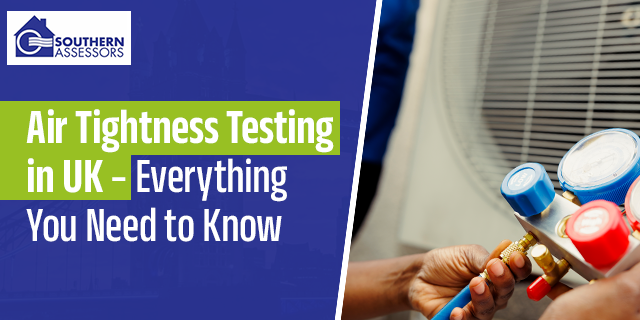Air Tightness testing, also known as pressure testing, measures how much air escapes through unintended gaps, cracks, and joints in a building’s external envelope. This testing process is solely focused on uncontrolled and unintended air movement, which is key to understanding how “leaky” a building tends to be.
So, why is air leakage detrimental to a building’s performance, and how does Air Tightness testing quantify it? How important is Air Tightness testing in the UK? Let’s find out.
Air Leakage & Air Tightness Testing – Why They Matter
Unlike ventilation, which is intentionally designed to encourage airflow, air leakage is the unintended escape of air that happens through unseen gaps in walls, ceilings, around pipes, and behind skirting boards. And while these leaks might seem minor, they quietly add up, leading to heat loss, energy waste, higher bills, and reduced comfort.
Air Tightness testing quantifies how well a building is sealed against unwanted air movement and thus helps understand whether it’s performing as intended or silently leaking energy. In the UK, air leakage is one of the primary concerns addressed under Part L of the Building Regulations.
Air Tightness testing in the UK is a legal requirement under Part L of the Building Regulations for new builds and major extensions. But compliance is only one part of the story.
Getting airtightness right is considered a core performance target, not just a checkbox. The right level of airtightness helps you:
- Stay warm in winter and cool in summer
- Avoid condensation, mold, and damp
- Lower your heating and cooling bills
- Improve your SAP and EPC ratings
A building with good airtightness performs better overall, with fewer drafts, more stable temperatures, and systems like MVHR functioning as they should. It also reduces the risk of moisture, improves resale value, and supports a long-term return on investment.
In short, Air Tightness testing is not just regulation; it’s a diagnostic assessment that helps in creating safe, comfortable, and energy-efficient spaces that last.
So What Does the Air Tightness Test in the UK Involve?
A blower door fan is used to pressurize or depressurize the building. Then, it measures how much air escapes through the building fabric at a set pressure (usually 50 Pascals). The result is expressed as m³/h·m²—the volume of air leakage per square meter of the building’s envelope per hour.
What Types of Air Tightness Tests Exist?
- Domestic Dwellings: Applies to most new homes. The standard target is usually ≤5 m³/h·m², though it depends on the SAP design. Homes must be tested individually unless part of a validated sample group, which has strict conditions.
- Commercial & Mixed-Use Buildings: Typically held to stricter targets. Larger or more complex buildings may require zonal testing, multiple fans, and integration with mechanical systems.
- Extensions and Large Refurbishments: If the new area exceeds 1,000 m² or significantly alters the thermal envelope, testing is required. For smaller projects, it’s still strongly advised, especially if targeting high EPC scores.
Why Do So Many Projects Miss the Mark with Air Tightness testing in the UK?
Because Air Tightness isn’t something you can “fix at the end.” Failures typically come down to:
- No planning for airtightness in the early design
- Poor sealing around junctions, pipes, and service penetrations
- Confusing ventilation systems with leakage control
- Testing too late in the process
- Lack of pre-test preparation or checklist
Failed tests result in delays, rework, additional costs, and stress. And if the re-test is rushed or unresolved, it might still fail, wasting even more time and budget in this process.
Why the Right Air Testing Partner Makes All the Difference
The best Airtightness services in the UK don’t just test and leave. They help you build a compliant, comfortable, and low-emission property that performs as expected and, in the process, meets the compliance requirements naturally. An ideal Air testing partner is someone who:
- Knows the ins and outs of Part L, SAP, and EPC requirements
- Shares a clear pre-test checklist so you’re fully prepared
- Helps identify and explain where leaks are happening
- Can guide on sealing tricky areas like ducting, hatches, and soil pipes
Planning a build or extension and looking to ace Air Tightness testing? Test it with our accredited team of professionals at Southern Assessors, who can get it right for you – first time, every time.
Need Air Tightness Testing Across the UK?
As leading service providers of Air Testing in the Hampshire UK, Southern Assessors combines technical expertise with a proactive, people-first approach to ensure every airtightness project is smooth, supportive, and straightforward.
- When you book with us, we provide a clear pre-test checklist to ensure your site is well-prepared from the start.
- Our experienced engineers not only conduct the test with precision but also help identify any areas that require attention, often right on the spot.
- If adjustments are made on-site, we offer a free re-test to keep things moving. You’ll receive your results on the spot, with guidance if needed.
Above all, we believe every step must be smooth, easy, seamless, and affordable. So, if you’re looking for Air Testing services in UK, we will beat any like-for-like quotation for Air testing services in Hampshire, Air Testing services in Sussex, Air Testing in Dorset, and Air Testing in Wiltshire. For more information about our Air Tightness testing services in UK, here.
Got more queries? Checkout our FAQ section on Air Testing Services in UK to find answers.


